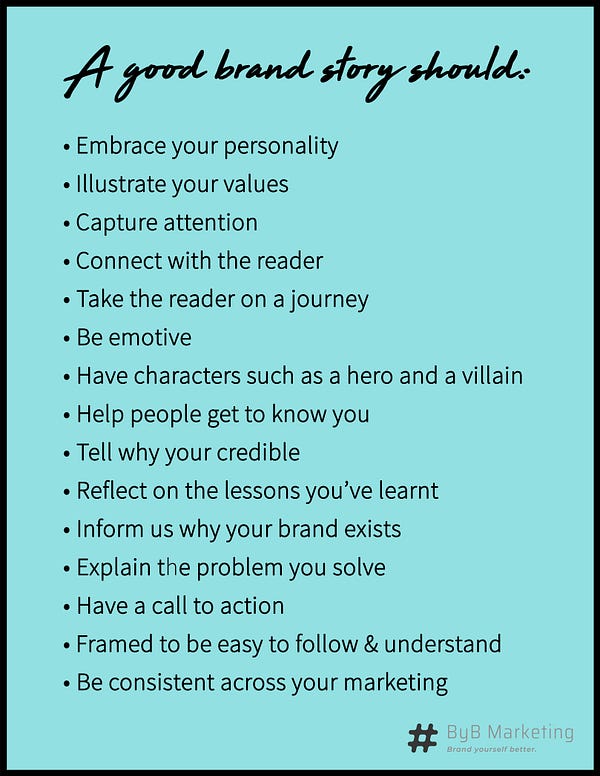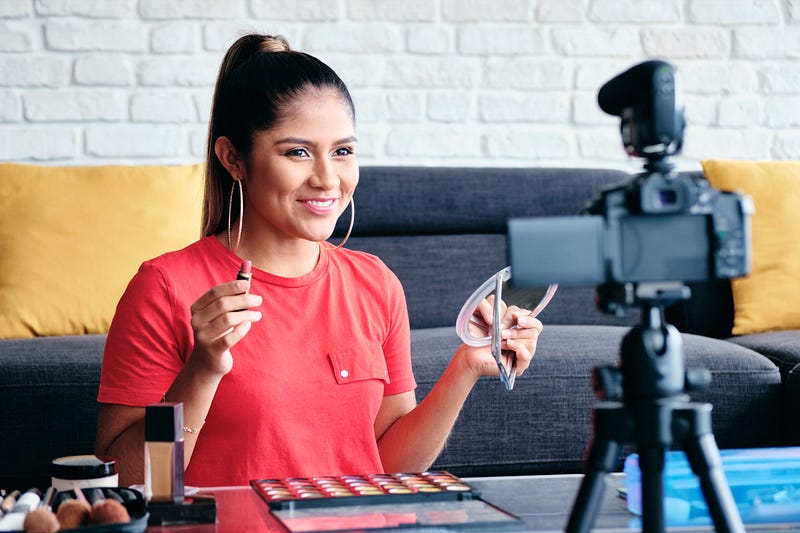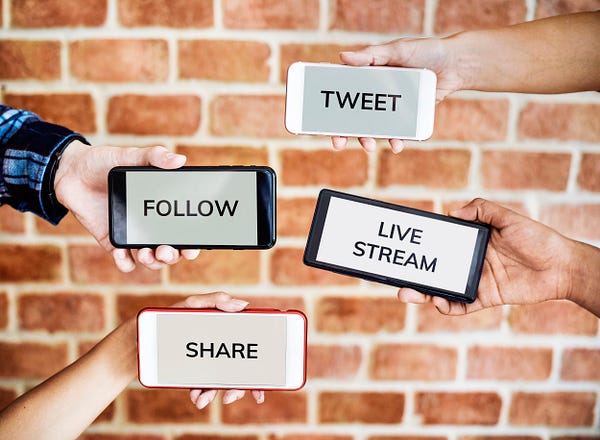 |
| Social media in 2020 |
Social Media Trends for 2020
As a marketer or small business, it’s important to stay on top of all the latest trends in the fast-evolving world of social media. Luckily for you, I’ve compiled the biggest trends into this article for your convenience!
Bear in mind, you’ll find no reference to COVID-19. No quick fix marketing scams here to make a dollar out of this disaster! Many of the trends I will be discussing have been growing for the last couple of years, rather than the flavour of the month.
Each week, I talk about marketing theory as well as the practical implementation of a different marketing theory or topic. We don’t just want to talk about the “what”, we think it’s important to understand the “how” and “why”.
 |
| Social Media |
The growth of social media
We all know what social media is, but how do we define it?
Social media is an online community, where people connect through electronic communication and share stories, ideas, opinions, thoughts and other content to generate discussion. It can be through a website or an app. Another characteristic is that users create service-specific profiles and can connect with other users, brands and join groups.
Over the short lifespan of social media (about 15 years), platforms have evolved, come, and gone. MySpace originally set the trend as the biggest social media network between 2005 and 2008. By the time the Facebook movie came out in 2010 called “The Social Network”, social media was a normal part of life for many people. Now, the number of internet users was 4.4 billion in 2019, and the number of people using social media was 3.5 billion.
“Social media is internet-based resources for sharing and discussing any topic. Any website which allows the customer to discuss their material, views, views and motivates connections and group developing can be classified as social media.” (Sajid, 2016)
According to Wikipedia, there is a general agreeance that social media includes the following: blogs, business networks, collaborative projects, enterprise social networks, forums, microblogs, photo sharing, products/services review, social bookmarking, social gaming, social networks, video sharing, and virtual worlds.
Social media has become an integral part of people’s lives and daily routines. Checking their social media accounts is the first thing many people do upon waking in the morning!
Over the past ten years, marketers have come to realise the importance of social media in peoples’ lives, and brands have saturated platforms like Facebook and Instagram with advertising and content to connect with their target customers. There is a lot of competition, so it is difficult to stand out without a strategy.
Choosing the right social media channel
Many brands rely on social media platforms as their major communication channel to reach their target audiences. The difficult part is, consumers are scattered over many social platforms. Social media is a dynamic and competitive space, any edge you have on your competitors in reaching your audience will give you an advantage.
Whilst the major platforms still dominate, there has been a rise in alternative platforms. Platforms like Facebook and Twitter have seen drops in users, with younger audiences opting to spend time on other platforms such as Snapchat and TikTok.
Generally, marketers have concentrated a lot of their effort on major platforms such as Facebook. But every business will have multiple audiences, it is not just one type of person. Even if most of the characteristics of a consumer are similar, they will like to consume content in diverse ways. All popular Social media platforms all have one characteristic that makes them best-suited toward a particular form of content, which influences its type of users it has.
Segment your audience into distinct groups of customers, and then tailor your communication to suit the preferences of each group. Assuming your audience is one type of person means you are ignoring potential customers who might be hanging out somewhere else and likes a certain form of communication. The better you know the diverse types of people most likely to be your customer, and their preferences, better you can adjust your messaging and narratives to fit each segment.
Trust and goodwill are the basis of social media, which uses the “wisdom of crowds” in a collaborative manner. (Sajid, 2016)
 |
| LIKE! The rise of social media |
As trends evolve on social media, so must the corresponding marketing. Over the past ten years, with the prominence of social media, the digital world has become saturated with brands’ marketing. Staying updated on the latest social media trends can help fuel your strategy and make you stand out in the crowd. Here are eight social media trends that you need to be aware of for 2020 and beyond.
Telling a human story…
Social media is synonymous with sharing our life experiences with friends and families. We share stories through our posts. Social media platforms are evolving with trends, allowing people to tell their stories in diverse ways. Video is continuing to increase in popularity as a way for people to share their narrative through platforms such as Instagram, Snapchat and Facebook.
Brands are following the lead and connecting with consumers on a more personal level through sharing more human stories of their own. Storytelling has become an important function of social media, as it feels real, immediate and personal. A brand can share their story in a number of ways, such as a creative mix of video, images and graphics.
 |
| Important elements of a brand story |
Distributed through social media, stories tell the narrative behind the brand, which capture moments and experiences shared by consumers of a brand or product. A human face to a business and brand is helpful to increase trust and loyalty as it helps the brand seem more relatable. Using the personal brand of the business owner in marketing content is an effective way to humanise a business.
Influencers
Influencers are already all-over social media. They are probably most obvious on Instagram and YouTube. These people get paid massive amounts of money to promote brands in their content. It can be much cheaper than running ad campaigns with impressive results, so it has become increasingly popular with brands as a marketing tool.
Influencer marketing should continue to be popular. This is the use of social media figures or influencers”, who have a community around them, to essentially be a salesperson for the brand. They include brands in their content in a way that is more like product placement or product endorsement. less direct than traditional forms of advertising This is to help humanise a brand. To give it a human voice. They can influence their following through the trust they have already built with the platform. It comes across as a more authentic form of marketing, even though it is still just marketing!
Signs are that consumers might be starting to see through the strategy, however. There has been a rise in “fake likes” on platforms like Instagram, so using likes as engagement metrics to measure the value of the influencer. The use of “nano-influencers” is increasing, which are accounts with a few thousand followers, instead of millions. Brands are moving away from big influencers to networks of these small and relevant niche influencers.
Make a more meaningful connection with a more engaged audience, not just for the “likes”. These influencers get much higher engagement and cost much less. If you are considering influencer marketing, consider what they bring to your business and whether their audience is meaningful to your brand.
Video content
Most smartphones for more than $100–200 these days should come with a camera good enough to produce a video for social media. With the barrier to entry lower than ever, video content is becoming increasingly popular with people creating content as well as consumers. Whether it is short-form videos like those popular on TikTok or Stories or long-form content on YouTube. One study suggests that by 2022, 82% of all online content will be video content.
Platforms are introducing more features for video content, such as Instagram introducing landscape videos, which will make it easier to repurpose video already produced for other formats. TikTok has an insane growth with younger demographics, with over 1.5 Billion downloads. But marketers and brands cannot harness the potential yet. However, the platform is working on ways that brands engage with their consumers. If you are not using video already, you should be thinking about it.
 |
| A woman creating a video of a makeup tutorial |
“Selfie videos” are drawing high user interest on social media. Like the selfie photo, the selfie video allows users to capture a moment in time, but the video format allows users to communicate in a deeper and more personal way than a photo ever could. Selfie videos tend to be less than 5 minutes long. Brands should look to create some content to connect with their audience via the ‘selfie” view of the lens. It will help you come across as more authentic, relatable and trustworthy.
Short-term content (Stories)
Short-term content (Ephemeral content) is available only for a short duration and disappears afterwards. “Stories” — which have become popular on Facebook, Instagram and Snapchat, are examples of this type of content and one of the biggest social media trends over the past few years. There are over a billion people combined using stories.
Some social media users spend hours lying on the couch watching friends’ and brand “stories” on Snapchat, Instagram and Facebook. One thing that makes Stories so attractive that they are short and engaging. You can add polls, questions, links and other content that allow you to go back and forth with your audience and makes it more exclusive. People’s attention spans are short on social media, so stories are a fast and convenient way to consume content.
Hyper-targeting & Personalisation
Hyper-targeting is a marketing strategy where a customer is pinpointed with targeted and relevant communication where they are most likely to see it. Google, websites, Social media… Over half of consumers think that the brand communication they receive is irrelevant. People are starting to expect to see advertising tailored to them. They want exclusive offers and discounts. It is a marketer’s job to meet those needs.
Every social media platform allows you to filter your audience with paid advertising. From geographic to specific market segments based on occupation, hobbies etc. Facebook recently roll-out personalised ad experiences that allows brands to advertise with dynamic ads that use changing formats and calls-to-action depending on the individual.
After the first targeting, you then retarget the same people with more relevant content. The more ads you click on, the better it will understand your online behaviour and preferences. The cycle continues. Often after shopping for a certain product or doing research on Google, you start seeing related advertising on Facebook? That is hyper-targeting. The same ad will not work for ten different buyers’ personas. So, create ten different adverts based on those personas, and then target those people in the right places at the right time. That is the idea. Customisation.
Local Targeting / Geo-tagging
Location-based targeting is used to reach out to people in a certain location. This is common on Instagram and in the use of “Stories” where a location (geo-tagging) is added to a post, to draw-in a local audience. Social platforms provide the option to search for posts from nearby places or specific locations. If you add locations to your content, it will show up in these search results, helping local people find your brand and content.
Geo-targeting works especially well for promoted posts to help you target the right audiences. For example, if you use the “boost post” option on Facebook, you can also select the locations that you want to target. Facebook will show your posts to users in those locations. Brands can also use geo-targeting to get more people to attend their local conferences and brand events. Or, they can use location filters in their social media ads, to advertise only to a relevant, local audience.
There are a lot of benefits of location-based targeting on social media and you simply need to know how to leverage it.
Niche communities
Community is important to consumers. They feel a sense of belonging from communicating with people with similar beliefs or goals. People use consumption as a vehicle to fit into a community that reinforces who they want to be. There are increased opportunities for brands to create communities for people that fulfil this desire. Brands that focus on niche groups build deep connections that are not possible when speaking with a wide audience.
Facebook Group marketing has become a valuable way to market to smaller and private communities. These communities are social groups created by brands to provide a networking platform for their customers. These are usually private groups that like-minded people can join to talk about their shared interests. Users discuss topics, share experiences, and seek solutions. As more people become concerned about their privacy, they engage a lot more in content in these private communities. Businesses can also use these communities as a source of market research and to launch new products.
 |
| Social media on mobile devices |
Social Commerce Integration
People are becoming increasingly comfortable with the concept of social shopping. The recent introduction of Instagram shopping is an example of this. It allows brands to sell on the platform without having to send people to links and leave the platform.
Social media platforms have long been used to sell products, but as a gateway rather than on the platform itself. Now social media platforms are starting to become a mainstream retail channel like your website and offline stores, with increased social networks introducing features like shoppable posts. As social media continues to evolve, social commerce will continue to grow and give customers more options and ways to browse and buy within social networks.
Figures show 55% of online shoppers purchasing a social media channel, such as Facebook, Instagram or Pinterest in 2018.
· 87% of e-commerce shoppers believe social media helps them make a shopping decision.
· 40% of merchants use social media to generate sales.
· 30% of consumers say they would make purchases directly through social media platforms.
Technology — AR & VR
Social media will see a rise in the adoption of technologies like augmented reality (AR) and virtual reality (VR). Platforms are trying to create more engaging experiences to compete with other social media platforms. Facebook, for example, has introduced a virtual world where people can connect, play games, and explore.
While the adoption of VR for social media in infancy, the use of AR has been around for a few years now. AR filters are used on several major platforms like Snapchat and Instagram, introduced to enhance the visual content by adding digital elements to it and changing the way things look. They have become hugely popular. We have all seen the filters with the bunny ears or crazy makeup.
AR is not just restricted to photo filters for fun. Platforms are trying to provide better shopping experiences to their customers. Checking out products in AR via Facebook messenger, for example trying on makeup products. Augmented reality can have a lot of potential social media applications for brands. The major platforms will keep producing interesting applications of AR and as technology continues to advance, VR.
Customer service
Social media has become more than just a place for people to connect with their friends and share photos and videos. As well as for retail, social media is now being commonly used by brands for customer service. This transition has happened over the past few years with customers reaching out to brands via social media as a more direct way to reach the brands. Brands started to respond and the use of messenger for communication has become more widespread.
It is not just some one-off cases where customers post their questions or complaints on social media and brands respond. Now, it has become a significant enough customer service channel for brands to recognise it as one. And, it is one of the most important customer service channels, owing to the massive repercussions of not handling a customer well in front of other users. So, it becomes even more important for brands to handle these customers well.
Thank you for reading! I hope you learnt something about social media and the trends business owners should be thinking about moving forward to best communicate to their target market.
Cheers,

No comments:
Post a Comment